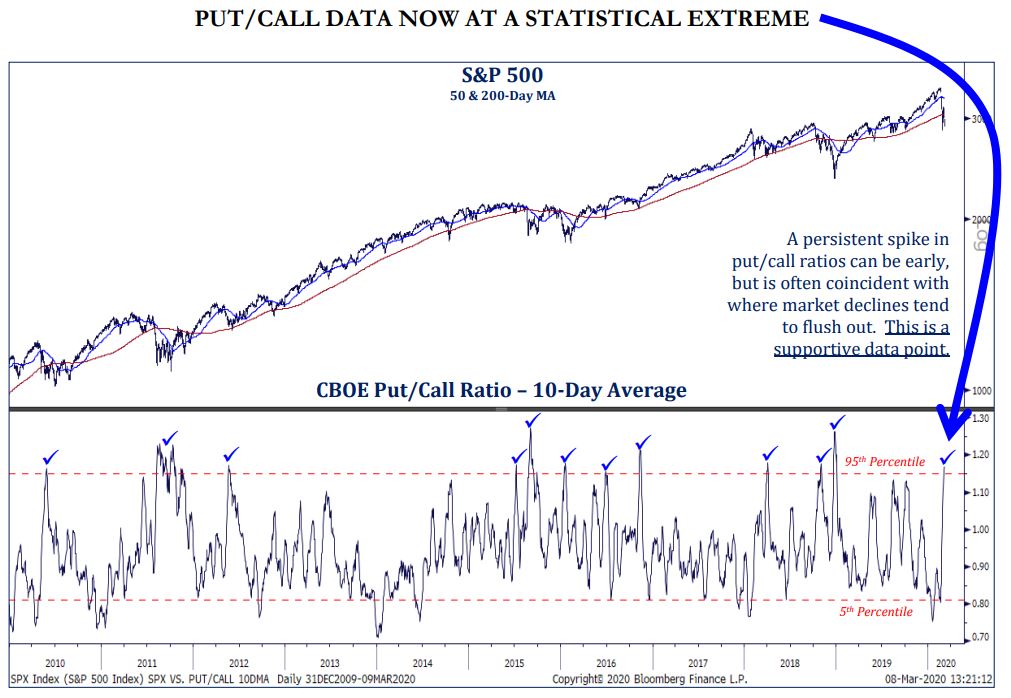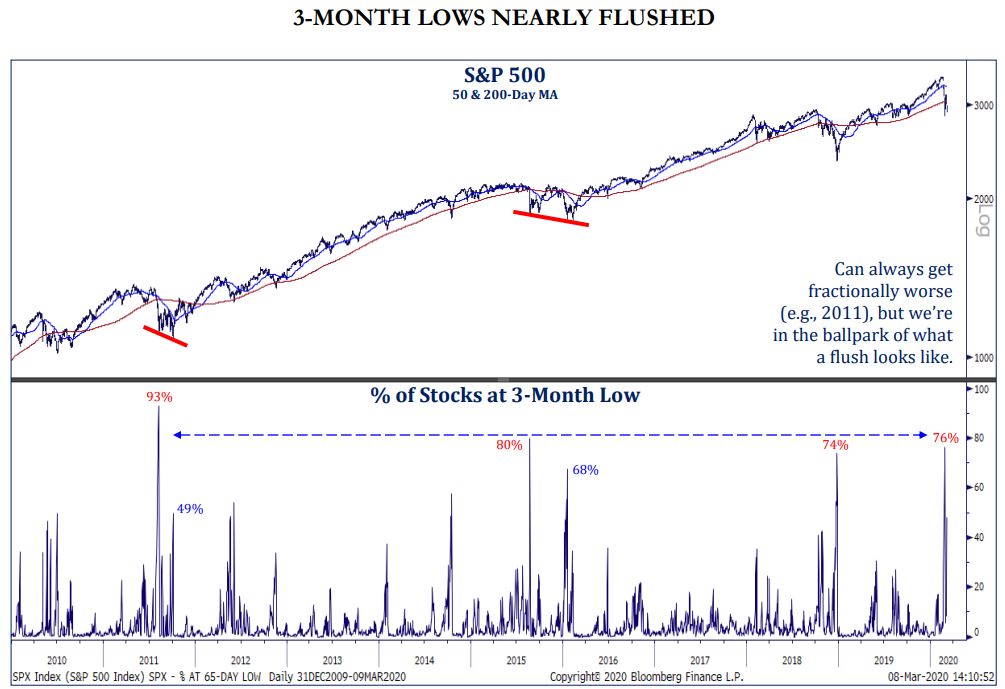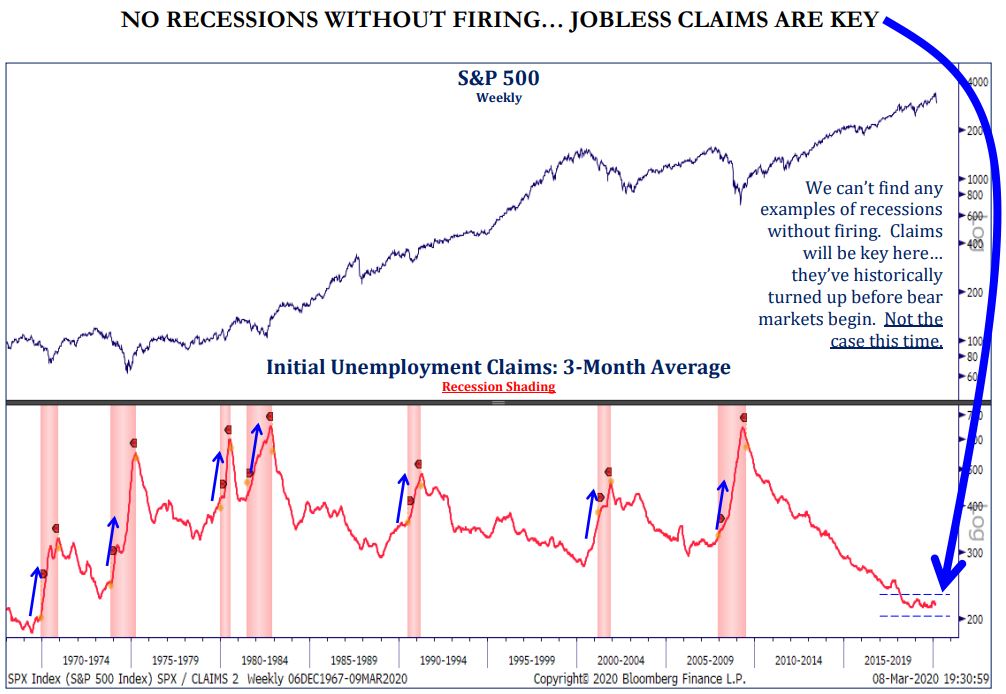Ironic – today, Monday March 9th is the 11th Anniversary of the March 2009 stock market lows, meaning this date was the start of the current bull market advance (we’re wishing it runs longer).
Generally, we are not fond of writing Market Alerts, as it often signifies market action that is unsettling to investors and clients. Further, no one knows exactly how to model a global pandemic. And, we usually don’t give a passing thought to the entity that China uses to describe its New Year, this year being called the “Year of the Rat.” Not to travel that path; yet most are well aware that rats carry all sorts of disease and illness if active pursuits of cleanliness and pest control are not followed. The global health environment appears to be actively searching for effective measures to curb the spread of Coronavirus. Additionally, Washington DC appears to be treating current events as mainly a health-policy issue.
The move overnight (weekend) in the 10-year Treasury yield and Oil is astonishing. Such a large move is most likely to assist creating a severe oversold condition and meaningful stress in sentiment over coming days. These are inputs often found closer to the end of a correction than at its beginning. Let’s summarize a few key factors pushing the stock and bond market (yields) down:
- With macro moves of this magnitude, there are often causalities – may be a leveraged player; a corporate group (energy?), or a country (Greece in 2011, or Saudi now?). It is not a pleasant exercise until the “whale” or “rat” is cleaned from the system.
- Oil – crude oil prices crashed, plummeting some 30% in early trading. US crude dipped below $30/barrel for the first time since 2016, and is down almost 50% since year end…. Why?
- Russia refused to participate in oil production cuts aimed at addressing tumbling demand. The Saudis launched a price war against Russia by suddenly lowering prices. The move is reminiscent of 2014 when the Saudis tried to shakeout US shale producers. Saudi Arabia can withstand a downside price shock better than any other, as it owns some of the lowest production costs in the world.
- Russia wants to economically hit hard the leveraged US shale producers who are pumping oil as fast as possible (creating a global supply excess far above demand) to keep cash flowing to cover their costs; Russia is saying, “start an economic war to combat US economic sanctions with low oil prices while global stock market prices are already down from Covid-19.”
- 10-year Treasury rates fell under 0.4% from below 1% last week (and near 2% entering the year). Such a move means investors are concerned about the unknown – and sell anything without thinking, and reinvesting in safety of the US Treasury….
- Recall though, as yields drop, prices rise. This huge dramatic drop in yields means the price of bonds is excessively high, or Greenspan used the term for stocks in 1999 as “irrational exuberance.” Selling stocks (after selloff) and buying bonds with proceeds here would be equal to selling low and buying high (opposite what successful investors strive to do).
- Stocks – are hitting levels indicative of panic selling…
- Over 95% of S&P500 stocks pay a dividend yield in excess of the US 10-year Treasury (wow!!! That again means bonds are really expensive)
- 76% of stocks are selling at 3-month lows (references: 74% on December 24, 2018; 68% in January 2016 when tariffs were first announced; 80% in late summer 2015; and 93% in July 2011 with European banking issues). It can always get “fractionally” worse; but we’re in the ballpark of what looks like a low.
- Bottoming is usually a process characterized by a “Bang” followed by a “Whimper.” In most market bottoming processes, it is “W” shaped, wherein the “Bang” occurs quickly followed by a series of testing up/down market moves, with a subsequent low occurring before the market resumes its longer rally.
- In 2015/2016, initial market correction was -13% representing 83% of the move down; total decline was -15% with total duration of the decline being 184 days; took 103 days thereafter to achieve a new market high.
- In July 2011, initial market decline was -20% representing 91% of the move down; total decline was -22% with total decline duration being 108 days; took 100 days thereafter to achieve a new market high.
- 2018 market correction in 4Q to December 24th, initial market decline was -20% with no retest or undercut; decline duration was 65 days; took 84 days thereafter to achieve a new market high.
- March 2009 (financial crisis), following a 17 month bear market, or 17 years ago (tech bubble) following a 33 month bear market – market action was a process of testing the first lows.
- Other examples of the bottoming process – 1962 (Kennedy-Cuba), 1984 (Reagan-Interest Rates), 1987 (October Black Monday), or 1991 (recession) – show a process of bottoming over time.
- Recessions do NOT occur without job layoffs. Jobless claims are a key to watch, as they historically turn up before bear markets begin.
“Kill those rats” – pest of market destruction.
Important to remember – when client investment objectives were established for your portfolio(s), we focused on time and purpose. By understanding the purpose of the savings and its time horizon before investing, one should be able to weather market storms when they occur. Financial market storms will occur; that is one thing we can guarantee (not returns). Thus, client portfolios own “buckets of time”, as we call it. Three buckets – “cash” or money market funds for monies needed in 12-months or less; “bonds” which provide better yields on savings which may be used for life’s needs over the next 2 to 5 years; and “growth” assets, like stocks and real estate, that are owned with a time horizon of 5+ years. [Corrections and bear markets in stocks do not last more than a couple years; bear market of 2000 to 2003 lasted 33 months.] “Buckets of Time” allow client portfolios to weather any financial market storm, permitting investors to remain rational, even if emotions become wary.
If one needed money right now, where would we get it from? Easy answer: from very, very expensive bond funds that are actually higher in value today compared to when this drawdown began.
Lastly, we regularly “speak” to being a “time-in” the market investor (not timin’ the market). Yet, at times like this, emotion kicks in high gear with the strong urge to sell like a trader. Fear of loss is great and can lead to bad decisions. The fear of future regret is something harder to master. Investors regret not buying great investments in times of market dislocation. Amazing, wealth is grown by remaining invested pursuant to your investment objective for the long term. That includes investing through the many ups/downs.
We are available to talk with you – by phone or coordinating a time to meet. Let us know how you are doing.
Supporting Charts (Source: Strategas Research Partners – 3/9/2020)
Market Alert – Seeing Clearly in 2020 Vision: Year of the Rat
Author: Bill Henderly, CFA – March 9, 2020
Informational Sources drawn upon:
- “The Daily Shot” from The Wall Street Journal
- Strategas Research Partners
- T. Rowe Price – Crisis Playbook March 2020


